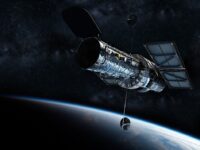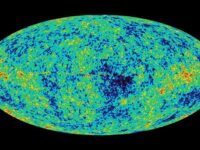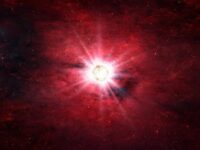Late afternoon on Sunday, June 13, NASA Goddard Space Flight Center received an unlucky but increasingly familiar message: The Hubble Space Telescope entered safe mode. The telescope’s primary computer halted, likely because of degrading hardware. NASA’s inability to send astronauts on a servicing mission, due to the Space Shuttle’s retirement, severely limited the Goddard team’s options. After a month of troubleshooting and with no other viable solutions left, they permanently switched the telescope onto its backup hardware, placing Hubble on its last leg.
After a month of troubleshooting and with no other viable solutions left, they permanently switched the telescope onto its backup hardware, placing Hubble on its last leg.
“The Hubble Space Telescope has been revolutionary from both a scientific and cultural perspective,” Northeastern professor and cosmologist Dr. Jonathan Blazek told NU Sci. “Hubble’s data have provided insights into a range of topics in astrophysics, including star formation, early galaxies, gravitational lensing, galaxy clusters, and structure in the Universe.” Hubble’s faltering marks a somber moment for many astrophysicists — but hope for the future remains high. A week before NASA Goddard announced Hubble’s computer failure, they updated the public on the readiness of their next-generation flagship observation tool: the James Webb Space Telescope.
Destined for launch in late 2021, the James Webb Space Telescope (JWST) will give scientists an unprecedented high-definition view of the cosmos with a primary mirror over twice the diameter of Hubble’s. JWST focuses on lower frequency light waves that can pierce through cosmic gas clouds, allowing scientists to observe what was previously obscured. These unique capabilities promise to bring a new wave of scientific discovery within our understanding of the early Universe, the search for alien life, and the history of our Solar System.
Only a few miles down the road from NASA Goddard, Dr. Michael Kelley is a cometary researcher at the University of Maryland. Kelley and his colleagues foresaw JWST’s abilities in a 2016 paper outlining applications in studying the makeup and driving forces of comets. In a statement to NU Sci, he said, “Comets are primitive objects that formed in the early Solar System. In a way, they are time capsules … their preserved material tells us about a period in our Solar System’s history that we can never visit.” Like a prism creating a rainbow, the telescope can sort detected light by wavelengths. Paired with its high resolution, this will allow scientists to identify distinct wavelength patterns of different molecules and pinpoint their location within comets, potentially helping researchers understand how our Solar System’s planets formed, what role interstellar matter played, and where Earth’s organic material came from.
Like a prism creating a rainbow, the telescope can sort detected light by wavelengths.
JWST’s spectroscopy has applications far beyond our solar system. The Astrobiology Institute at the University of Washington wants to use this capability to look for alien life. Megan Gialluca, a graduate student at the Institute, focuses on searching for biosignatures on exoplanets orbiting small red dwarfs. In a 2021 paper, Gialluca proposes using spectroscopy to observe the shadows of exoplanet atmospheres as they pass in front of their stars. The results could reveal which element and molecule signatures are present. “JWST will be the most promising mission to detect exoplanet atmospheres to date,” Gialluca told NU Sci. Using simulated planetary transits and JWST instruments, Gialluca determined observations could detect methane, carbon dioxide, and oxygen on an exoplanet within only a couple dozen transits — a feat not possible by Hubble because of its lower resolution. The detection of a biosignature or combination of biosignatures that provide indisputable evidence of life is a long shot, but Gialluca is an optimist, saying, “I think it would be one of the single greatest discoveries of our time — although I am certainly biased!”
Dr. Eniko Regos, an astrophysicist at the Hungarian Academy of Science, hopes to look back even further: to the Universe’s first stars and black holes. As the Universe cooled off from the Big Bang, it went black — entering the cosmic dark ages. It was not until hundreds of millions of years later that gravity finally began collapsing gas clouds into stars, littering the primordial night sky with light. In a series of three papers, Regos outlines how researchers could use a proposed JWST survey to search for detections of light from the first supernovae of exploding stars and spacetime collapses that created the first black holes. These findings could provide insights into the formation of the Universe, how the first galaxies formed, and how the modern-day mysteries of dark matter and dark energy influenced this period.
As these teams and hundreds of others around the world contend for observation time, most proposals are met with rejection, and the few accepted are cherished. NASA’s focus is first on observations they believe will yield important results quickly, as a form of mission assurance should the telescope fail early on. “There are so many great ideas, but only so much telescope time available. So, the excitement of having a proposal selected is tempered by the rejected projects,” Kelley admitted. The Astrobiology Institute has experienced similar difficulty, and while the survey Regos highlighted was not included in the first round of selections, similar ones made the cut.
NASA’s focus is first on observations they believe will yield important results quickly, as a form of mission assurance should the telescope fail early on.
As a shared instrument, JWST has already brought astrophysicists together to collaborate on proposals and celebrate the awards of their colleagues — especially since NASA requires scientists to distribute observational data with the entire community. “I see the process as a lot of fun,” Kelley said. “Getting colleagues together and trying our best to solve problems with creative approaches is an important aspect of science.” Gialluca agreed with this sentiment, saying, “JWST is going to be helpful for so many different subjects of study. In this way, and like Hubble, it will really be a tool to bring the whole astronomical community together, with something for everyone to get excited about.”
The Astronomical Society of the Pacific (2016). DOI: 10.1088/1538-3873/128/959/018009
The Astronomical Society of the Pacific (2021). DOI: 10.1088/1538-3873/abf367
The Astrophysical Journal (2019). DOI: 10.3847/1538-4357/ab0a73
The Astrophysical Journal (2021). DOI: 10.3847/1538-4357/abdf51



